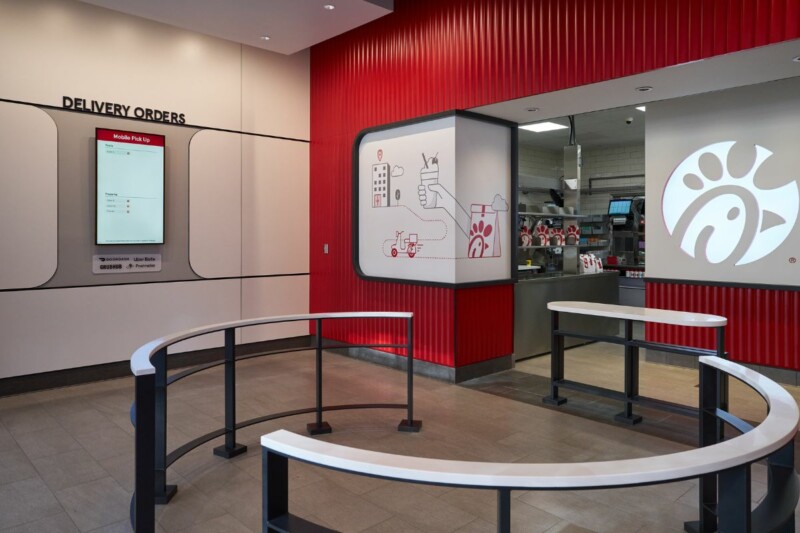With an ivory 1961 Vespa parked on top of the vestibule, wine-crate lined counters and an all-fresh menu lineup, Go Roma: Scratch Italian Pronto!’s prototype in Glenview, Ill., has become a rising star for the concept’s new owners, Dallas-based private-equity firm Chalak Mitra Group. What sets the fast-casual eatery apart is its super-compact open kitchen anchored by a “faux” stone-hearth oven (stacked conveyor ovens in an enclosure) and “faux” wine kegs showcasing on-tap wine and beer.
Three weeks into its soft opening, Go Roma managers expect to serve up to 350 daily covers as word gets out. The 2,550-sq.-ft., 71-seat prototype with its 205-sq.-ft. kitchen is expected to generate $1-$1.2 million in annual sales. The figure is slightly south of the other two existing stores’ sales, but the prototype, with its smaller footprint, also enjoys lower rent and overhead.
Efficiency On Display
The two lead designers for the Go Roma prototype are Alicia Tomlin, Chalak Mitra Group’s Director of Construction and Facilities, and Tony Pavic, Go Roma’s Operations V.P. and a 10-year company veteran. Their goals were to showcase the kitchen and streamline labor in a smaller overall footprint.
“In 2004, when Go Roma debuted its first few stores, the idea of an open kitchen was still relatively new,” Pavic says. “We thought a shoulder-height window in the cooking area counted as ‘open.’ But all you really saw were floating heads behind the order counter.”
The new design simply moved the kitchen cookline forward and about 8 ft. to the right, placing it in line with the order area and in full view of guests. “We wanted to make the guest experience more exciting,” Pavic says. “Now you can watch us stretching dough or making the pizza you just ordered through the glass panels. It’s clear we’re not opening bags or pulling things out of freezers. All the food is made here.”
The kitchen consists of the four stations used in all Go Roma restaurants: Pasta, Pizza, Salad and “Cutter,” where hot pizzas are cut and plated. The star of the cookline is a pair of stacked conveyor ovens hidden within an enclosure resembling a stone-hearth oven. Three heavy-duty Vollrath induction burners, a Pitco/Middleby pasta cooker and a Garland/Manitowoc convection oven—which doubles as a smoker—make up the front cookline. Cold drawers below hold ingredients at the ready. A single-vat fryer, used mainly for fried calamari, sits to the left of the Salad station. Hanging heat lamps and an undercounter warmer keep to-go orders hot.
Induction burners and tilt skillets have been part of Go Roma kitchens for several years, but the prototype relies solely on induction for all stovetop cooking. “They’re powerful enough to handle large kettles of sauces or soups, they’re fast, and they’re compact enough to fit in the smaller space,” Pavic says. When not in use, the units’ flat tops can be used as work surfaces.
The display kitchen is supported from behind the scenes by a compact, 700-sq.-ft. production area that includes a small prep area, walk-in cooler, dry storage and warewashing. Because so much of Go Roma’s menu is prepared fresh, the design team was able to replace the walk-in freezer with a reach-in freezer.
The new layout, with the stations compressed together in front, boosted labor efficiency. “I can be working the expo table, stop to take an order and be back at expo without missing a beat,” Pavic says, gesturing toward the registers a few steps away. The design also sustains Go Roma’s emphasis on serving guests by keeping employees front-of-house. “We want guests to be able to come through the door, order, get their drinks and then not have to get up again until their meals are finished.”
The new layout can operate with seven or eight workers at peak times and only two during slow times. By contrast, the two existing—and slightly larger—Go Roma locations require about 10 workers to run the show on busy nights and five workers during slow times.
Conveyor Ovens Under The Faux Dome
A casual visitor might glance into Go Roma’s cookline, notice the signature dome and assume a stone-hearth oven lay beneath. The dome, however, was built to surround a pair of stacked TurboChef impingement conveyor ovens. The smaller top unit is used for toasting sandwiches, and the larger bottom oven is reserved for pizzas. Copper doors at the dome’s front hide the ovens while allowing easy access for maintenance and cleaning.
“The enclosure was the first thing we designed for the prototype, with input from the manufacturer,” Tomlin says of the dome, which features black, polished pebblestone tile, riveted copper doors and a copper chimney cap. “We’d talked about how to give the open floorplan an artisanal feel, something pleasing to the eye that represents old-world Italy. I sketched out my idea for a dome, and everyone loved it.”
While a stone-hearth oven could have been a natural fit for the concept, Go Roma’s cramped space and its right-to-left work flow depend on conveyor ovens. Pizzas and hot sandwiches are built on the far end, put into the ovens and taken out at the expo table for cutting and plating.
The ovens’ digital controls for airflow and heat allow baking to be fine-tuned easily. “We can send more hot air to the top or bottom of the item cooking as needed,” Pavic says. “When we were first testing the ovens, we probably sent about 10 pizzas through, one after the other, to perfect the settings.”
Technology advances mean the new conveyor ovens work about 50% faster than the ovens used in existing Go Roma locations, taking two-and-a-half to three minutes to bring a pizza to bubbly perfection. What’s more, the units can operate without a hood, saving on equipment and installation costs.
The Go Roma team had to make a few tweaks to the dome after opening. “The full length copper doors blocked the airflow, causing the ovens to overheat,” Tomlin says. The solution was to make the doors half-size and install a stronger exhaust fan to increase airflow. The open space below the ovens now is used as a warm spot to store parbaked pizza crusts.
Faux Kegs And A Galvanized Trough
Behind the order counter, two large, wooden wine kegs project a few inches out of the wall behind the order counter. A tap in each of the kegs dispenses white or red wine, while another set of taps, installed in the wall between the kegs, dispense beer.
“The design started as a sketch, then I worked with our rep at Perlick to make it happen,” Tomlin says.
The actual wine kegs, in the form of stainless canisters, are held below the taps in a Perlick dual-temperature wine cooler. Beer kegs reside on the opposite side of the wall in the walk-in cooler, with only a short run to reach the taps out front.
Instead of a traditional (i.e., boring) drip catcher below the taps, Tomlin went creative. She purchased a galvanized metal feed trough from a tractor supply shop near Dallas and asked the company’s fabricator to convert it into a working drain unit. “The trough has a custom stainless inset and grate, so it’s NSF-approved,” Tomlin says.
A Look Ahead
Assuming Go Roma’s prototype proves a success, Chalak Mitra Group expects to open a fourth location in the Chicago area this year. Next year will bring up to three new stores in the Dallas market.
MENU/SEGMENT: Fast-casual Italian
HEADQUARTERS: Dallas
FOUNDED: 2004
NO. OF UNITS: 3
PROTOTYPE SIZE: 2,550 sq. ft.
NO. OF PROTOTYPE SEATS: 71, plus 26 patio seats
EQUIPMENT PACKAGE: $150,000
PLANS: 1 additional opening in 2015; 3 in 2016
DESIGNER: Alicia Tomlin, Director of Construction and Facilities, Chalak Mitra Group, Dallas
ARCHITECT: Tom Morgan, Principal, Civitarese Morgan Architecture, Dallas
MARKETING DESIGNERS: Shannon Phillips, Design Director, Johnson & Sekin, Dallas; and Liz Jones, Marketing Director, Chalak Mitra Group, Dallas
DEALERS: Ben Whitlock, General Manager, and Ann Kanehl, Project Manager, Mobile Fixture & Equipment, La Vergne, Tenn.
CONTRACTOR: Paul Tanzillo, President, RSI Construction Services, Columbus, Ohio
WEBSITE: goroma.com
“””
RELATED CONTENT
- Advertisement -
- Advertisement -
- Advertisement -
TRENDING NOW
- Advertisement -
- Advertisement -
- Advertisement -


